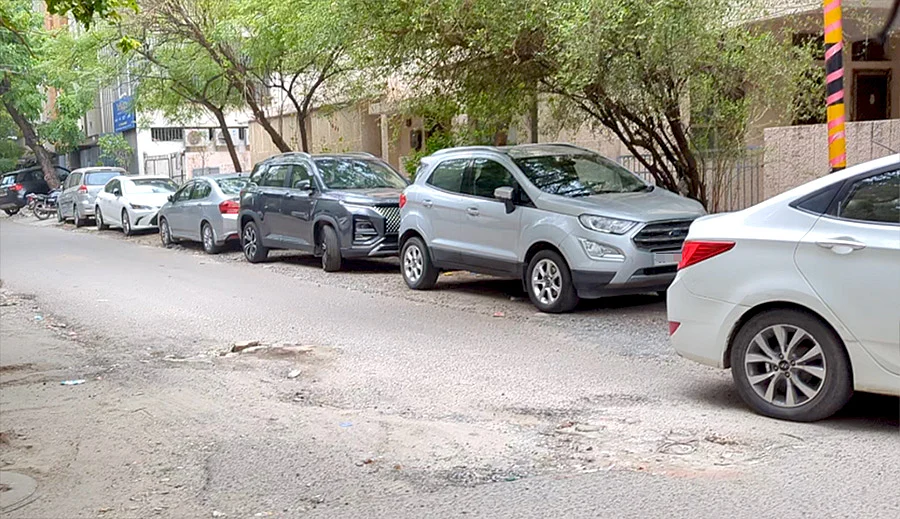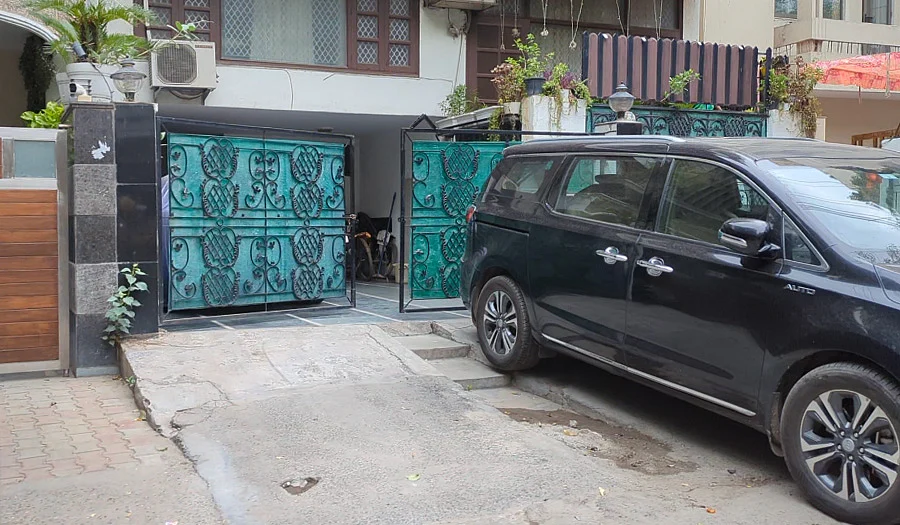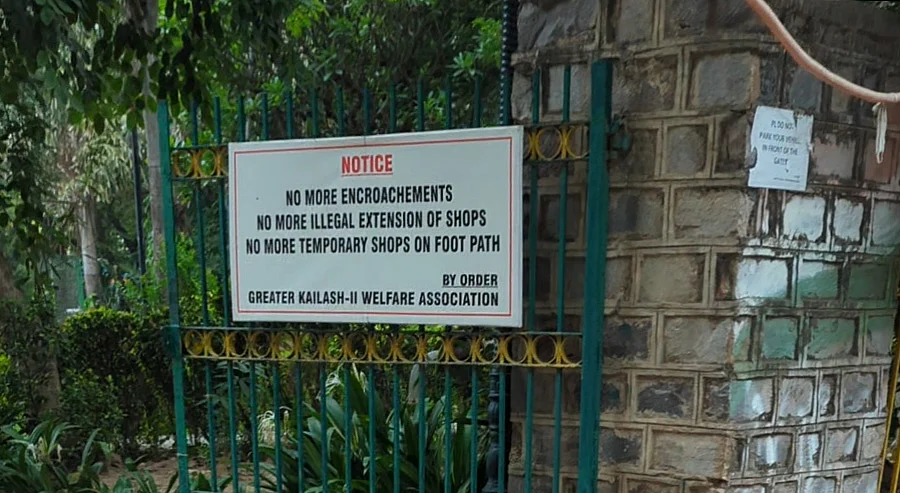Pedestrian zones as driveways, parking lots: The elite encroachments Delhi won’t touch
Despite clear urban planning norms, pavements in South Delhi’s elite enclaves are swallowed by private use.
Read the previous parts of this series here.
“No more encroachments. No more illegal extensions of shops. No more temporary shops on footpaths,” reads a board near a park opposite M Block Market in Greater Kailash-2.
But just a few steps away, cars are jammed into every available space – on roads, in front of shops, even the street right across the market. Cutting off footpaths and pedestrian access.
It’s a scene that repeats across South Delhi’s affluent enclaves. In Greater Kailash-2, CR Park, Defence Colony, and New Friends Colony, public walkways – where they exist – have been swallowed by private use.
This, in a city where thousands have been displaced in demolitions over illegal constructions and encroachments.

‘Barely any footpaths’
Today’s Greater Kailash, with its boutique stores and gated homes, was once farmland. In 1955, the government acquired this land from farmers in Zamrudpur and Devli Gaon. By 1959, it handed over a portion to real estate giant DLF for a residential colony. The success of Greater Kailash-1 eventually led to the development of Greater Kailash-2, which offered better connectivity to the Outer Ring Road of New Delhi.
Now, there are over 6,000 properties in GK-2 alone. Many homes have more than one car, often without adequate parking. The result is a spillover of cars onto lanes.
Newslaundry visited blocks M and E.
In M Block, the pedestrian zone in one lane was occupied entirely with cars parked outside houses.
In E Block, beyond gate number 4, houses on both sides have huge driveways with parked cars.
According to the Indian Road Congress guidelines, footpaths in residential areas are required to have three distinct zones, a frontage or dead zone, a clear pedestrian zone, and a furniture or multi‑functional zone, with the pedestrian zone alone being at least 1.8 metres wide. As per these guidelines, the walkability score of a road depends on “footpaths that are free of encroachments”, among other factors.
But Sanjay Raina, secretary of the GK-2 Residents Welfare Association, claims “there are barely any footpaths inside the colony except on the main roads”. He points out that where stilt parking was not built, residents often resorted to planting pots or placing tiles over the drains, areas originally intended to be paved as footpaths. “But since there’s no proper drainage, footpaths were never built, and now people use that space as an extension of their homes.”
Despite multiple complaints filed with the MCD, Rana claims the response has been the same each time: “No funds.”
Rana says they have approached the Delhi High Court against encroachments, but only those by vendors in the market. The matter is subjudice.
Geetam Tiwari, Chair Professor at IIT Delhi’s Transport Research and Injury Prevention Programme (TRIPP), claims existing pedestrian guidelines are routinely ignored in elite neighbourhoods. “They are not legally binding. If they were, agencies could be held accountable and penalised…when cars occupy footpaths, pedestrians are pushed onto the carriageway. They’re exposed to the risks of fast-moving traffic and high-stress walking environments.”
Exacerbating the situation is the ambiguity surrounding parking spaces in residential neighbourhoods.
In June 2024, the Delhi High Court ordered MCD and DDA to frame rules and impose fines on those encroaching public land. But both authorities admitted they lacked mechanisms to do so. The court called for a framework to penalise violators and recover charges for the benefit of the public.
A 15-member Special Task Force, constituted in 2018 following a Supreme Court order, was mandated to identify and reclaim encroachments on government land across Delhi. In its latest report on May 29, 2025, the STF mentions clearing 191.7 km of roads and footpaths of encroachments, with 134,964 square metres of roadside area cleared in May by MCD (South). However, the same report notes that zero challans were issued by MCD (South) in the same month.
The authority received nearly 62,000 complaints related to illegal occupancy until May 31, with about 2,000 still pending. Of the complaints addressed, over 37,000 were classified as requiring “no action”.

CR Park: ‘Gets difficult to walk’
Just a few kilometres away lies Bipin Chandra Pal Marg, the road that defines Chittaranjan Park, locally known as CR Park.
After Partition, intellectuals and civil servants from the erstwhile Bengal region found themselves divided between East and West Bengal. Many migrated to India and began seeking a residential settlement in the capital. In 1954, a group formed the East Pakistan Displaced Persons (EPDP) Association and lobbied the government for land. By the 1960s, they were allotted land in what were then the remote, forested southern fringes of Delhi. Approximately 2,000 people were granted plots based on proof of residence and employment in the capital, laying the foundation for Blocks A through K. The colony later expanded with eight more blocks, accommodating around 700 additional families.

But the situation in CR Park is barely any different from Greater Kailash.
The stretch that leads from CR Park Market No.1 to CR Park Market No.2 has footpaths – but they change in height to match the main doors of adjacent houses. This is far from the guidelines by the Indian Road Congress, which state that footpaths must have a uniform height above the ground level for uninterrupted pedestrian movement.
There are several blocks near the road that connects the two markets. Newslaundry visited two of them — B Block and C Block. In these blocks, cars were parked across pavements, making CR Park no exception to the wider trend.
B Bose, honorary member of B Block Residents Welfare Association, says, “It gets difficult to walk on roads with no footpaths, especially for senior citizens like me. We have complained many times to the authorities, but hardly any action is taken. There is more than one car per house, and ultimately they end up parking on the land allocated for footpaths.”
Former DDA director and EPDP’s secretary Ashok Bhattarjee says there are footpaths on Bipin Chandra Pal Marg “but unfortunately they are either encroached by cars or vendors”. “Within the colony, the footpaths don’t exist. When it is so difficult to get footpaths on roads which are busier than the internal colony, one can only expect how difficult it is to get proper footpaths built inside the colony.”
Bhattacharjee says the association has repeatedly taken up this matter with MCD, traffic police and local police. “We are waiting for a concentrated effort to ensure the safety of the pedestrians.”
Dinesh Kumar, a former PWD official, claims the police have the power to seize or destroy objects like security guard booths or challan cars via traffic police. But enforcement has been weak.
Hitesh Vaidya, an infrastructure expert says, “Despite clear standards prescribed by the Indian Road Congress, enforcement in Delhi remains inconsistent, particularly in planned colonies. This inconsistency can be attributed to weak inter-agency coordination, political pressures, and inadequate institutional accountability.”
Asked for comment, Aashu Thakur, the councillor for CR Park (which also covers GK-2), says, “There are plans to conduct drives to remove encroachments from footpaths.”
Newslaundry reached out to MCD, DDA, and DCP Traffic (South) Kushal Pal Singh for comment. This story will be updated if a response is received.
Small teams can do great things. All it takes is a subscription. Subscribe now and power Newslaundry’s work.
